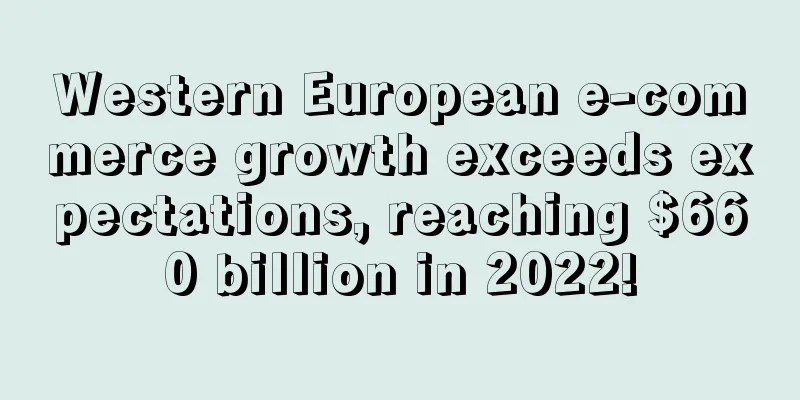Western European e-commerce growth exceeds expectations, reaching $660 billion in 2022!

|
According to eMarketer's survey statistics, since the outbreak of the epidemic, the e-commerce share in Western Europe has risen from 10% to 13.4%. It is expected to grow to 14.8% by the end of this year.
Previously, emarketer predicted that Western European e-commerce sales would remain below $580 billion by 2022. Later, emarketer revised the figure and predicted that Western European e-commerce sales would reach $660 billion by the end of next year. This is a significant upward adjustment compared to the previous forecast, indicating that the Western European e-commerce market has huge potential.
The survey pointed out that the epidemic caused retailers to quickly build infrastructure to support the growth of e-commerce sales, and the emergence of infrastructure accelerated the e-commerce transformation in Western Europe.
Online retail sales in Western Europe will continue to grow, both in terms of total sales and share of the entire retail market. It is expected that in three years, its online sales will exceed the $700 billion mark; in 2025, digital sales are likely to reach $758.46 billion, accounting for 15.9% of Western European retail sales.
Earlier data showed that sales in Spain will grow by 22.9%, the highest level in Western Europe and one of the fastest rates in the world, while the Netherlands and Italy will grow by 21.9% and 20.5% respectively .
Most of these countries have been greatly affected during the epidemic , and their e-commerce base is lower than that of some European countries, so they will grow faster. Overall, retail e-commerce in every country or region in Western Europe will grow by at least 12%.
Much of this growth will be driven by the explosion of online sales of consumer packaged goods (CPG) , the rise of online grocers, the ability of many brick-and-mortar retailers to quickly pivot to e-commerce, and the introduction of new online users by these new multichannel retailers.
Affected by the epidemic, Western European buyers have shifted from offline purchases to online purchases . The number of buyers who buy food, cleaning products and household items online has increased significantly, and they have gradually formed the habit of online grocery shopping.
Driven by digital shopping, e-commerce sales in Western Europe will jump 26.3% to $539.18 billion in 2020. In contrast, total retail sales in Western Europe will fall 3.6% to $4.049 trillion.
Amazon is one of the biggest winners in Western Europe during the epidemic . Consumers choose Amazon as their first choice for online shopping when local stores are closed or products are out of stock . Western Europe E-commerce |
<<: Cross-border full-link experience upgrade, Cainiao announced the Double 11 merchant support plan
>>: Brazilian e-commerce platform Infracommerce acquires Synapcom for $224 million
Recommend
What is Huafuda? Huafuda Review, Features
Huafuda Information Technology Co., Ltd. is the wo...
Another big seller is in trouble: about 130 million yuan of funds are frozen, and nearly 1,400 employees have resigned
Another super sale gone wrong! Today, another bre...
Sued for infringement! Shenzhen Dama paid nearly 1 billion yuan to settle
For cross-border sellers, intellectual property r...
What is Cleverbridge? Cleverbridge Review, Features
Cleverbridge provides global online checkout solu...
What is Directa24? Directa24 Review, Features
<span data-docs-delta="[[20,{"gallery"...
Is there a new trend for back-to-school season? Google reveals the popular trends
According to a survey conducted by the U.S. Censu...
Shenzhen is giving out money again! Rent exemption and rent reduction, with a maximum subsidy of 1 million
Shenzhen is giving out money again! Rent exemptio...
Starting today, Amazon has adjusted multiple charges!
Amazon will adjust a number of logistics and ware...
What is Mockingbird? Mockingbird Review, Features
Mockingbird is a store that specializes in designi...
What is voghion? voghion Review, Features
1. About Voghion Voghion is an emerging cross-bor...
Walmart's Flipkart may face $1.35 billion fine for allegedly violating foreign investment laws
Flipkart, owned by Walmart, has been in a lot of ...
What is Price Specter? Price Specter Review, Features
Price Spectre was developed in 2009 by eBay's ...
Despite closing thousands of stores, the net profit surged by 400 million yuan. What did Suntech do right?
As we all know, traffic is a very important facto...
Shipping company profits soared 32 times, have sellers become wage earners?
On the evening of July 7, COSCO SHIPPING Holdings...
Report shows: Indonesia's e-commerce penetration rate is higher than that of the United States and France
During the epidemic, e-commerce has flourished ar...









